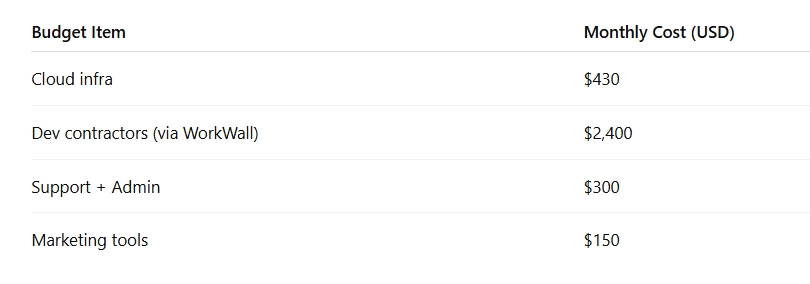.png)
.png)
In the beginning, I tried to manage everything in-house, from setting up infrastructure, pushing code, handling QA and even responding to customer emails. I thought doing it all by myself would cost less, but it only burned time and was more expensive. I had to move faster, but also didn’t want to compromise product quality. That’s when I started rethinking how I built, not just the product, but the team and workflows around it.
.png)




One of my early wins was streamlining the infrastructure. Rather than overbuilding, I focused on lean DevOps and pay-as-you-go cloud resources.
Read next:
DevOps on a Shoestring: Tech Stack Tips for Lean Startups
Key decisions:
Results: Infrastructure remained agile, costs dropped by 28%, and his dev team could push features weekly without firefighting.
I targeted remote-first SMBs with hybrid teams struggling with productivity tracking. My ICP (ideal customer profile) was clear:
I validated demand through user interviews and early LinkedIn cold outreach.
Insight: Many such companies now source on-demand dev talent through Tech Marketplace to augment product builds while keeping team size lean.
I quickly realized I couldn’t do it all. The constant context switching was unsustainable. Here's how I recovered focus:
Read next:
5 Processes to Automate Before They Burn You Out
This shift gave me back 12+ hours per week. I reallocated that time to customer discovery and roadmap refinement.
Alex’s go-to-market approach leaned heavily on content-led growth, side projects, and founder-led sales.

Read next:
From MVP to PMF: How Smart Tech Founders Scale Without Burning Out
Through this, I booked 15 demo calls in 4 weeks and signed 4 pilot users—all before exhausting my runway.
I used this lean allocation model:

Tip: Tools like WorkWall let founders like me post exact tasks or features, matching them with vetted tech contractors. You only pay for scoped work—perfect for unpredictable startup budgets.
I didn’t just build a product—he built resilience into his company. By being ruthless with focus, leveraging automation, and outsourcing smartly, I hit PMF and still slept 7 hours a night.
Key Takeaways:
Join other tech founders using WorkWall to post requirements, find vetted tech talent, and keep building—without burning out.
.png)





Picture this: a world where machines learn, adapt, and evolve autonomously, unlocking the doors to possibilities that were once confined to the realm of science fiction.

As a Tech Founder, we are not new to travel, we are also not new to networking within summits and events. But how do we make sure we are not missing out any event?

In today's tech landscape, global connectivity is key. For firms seeking global success, expanding beyond borders brings excitement and challenges.

In ever-evolving landscape of collaboration, WorkWall has emerged as a powerful solution for businesses seeking enhanced productivity, streamlined workflows, and efficient teamwork

In the ever-evolving landscape of technology, Tech firms, both large and small, are constantly seeking ways to work together and develop cutting-edge solutions and drive progress.

In an increasingly interconnected world, geographical limitations should no longer be a hindrance to business expansion and innovation.

In today’s globalized tech landscape, collaboration has emerged as a driving force behind innovation and expansion.

The world of technology is in a constant state of flux. With innovation hubs springing up across the globe, the global tech landscape is more dynamic than ever
In the realm of technology and innovation, geographical boundaries have become increasingly inconsequential.
Stay ahead of the tech curve! Subscribe to our weekly newsletter for a curated dose of the latest industry insights, project highlights, and exclusive updates.